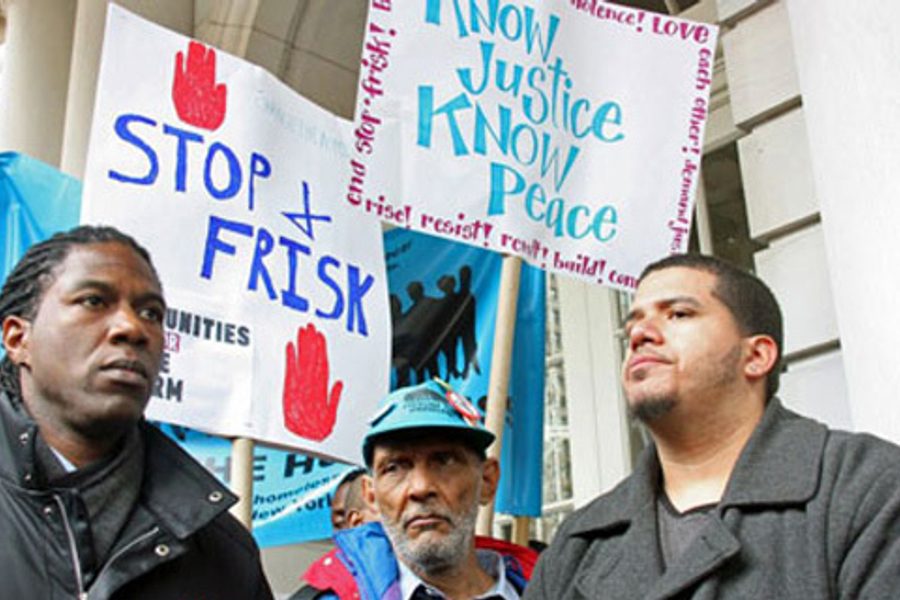Picturing an End to New York City’s Homelessness Crisis
More than 50,000 New Yorkers are homeless. Here’s what the new mayor could do to help.
Molly Knefel

Kendall Jackman was working as a federal employee for the United States Postal Service when her uncle had a heart attack in 2008. After taking time off to care for him, she was suspended from her job and eventually let go. Though she fought to keep her garden apartment in Bedford-Stuyvesant, Brooklyn, the neighborhood where she was born and raised, she eventually found herself joining the more than 50,000 people living in homelessness in New York City.
As New York prepares for the departure of its three-term billionaire mayor, with self-described progressive Bill de Blasio as his likely successor, a spotlight shines on the thousands of New Yorkers who, like Jackman, are suffering from the city’s housing crisis. Homelessness skyrocketed under Bloomberg’s tenure, and de Blasio has made affordable housing for all New Yorkers one of his campaign promises. For advocates and organizers, then, the mayoral election has been an opportunity to reassert the importance of finding a long-term solution for the city’s homeless population. One such organization, Picture the Homeless (PTH), is led by homeless New Yorkers who seek to amplify homeless people’s voices in a political landscape where those who are suffering are often left out of the conversation.
PTH was founded in 1999 by two homeless men, Anthony Williams and Lewis Haggins, Jr., in response to Mayor Giuliani’s escalating criminalization of homelessness. Since then, the organization has been directed and run by homeless members, fighting for housing and civil rights and against police brutality. Its name, as well as its motto — “Don’t talk about us; talk with us” — embody the group’s mission to empower homeless individuals to demand change on their own terms.
Jackman joined PTH after coming across its headquarters while living in a shelter in a nearby neighborhood; she’s now its Housing Campaign Leader. I sat down with her and Jean Rice, an original PTH board member and a current leader on the Civil Rights Committee, to talk with them about Bloomberg’s tenure and their vision for the city’s future.
Rice and Jackman, coincidentally, are currently living on different floors of the same Single Room Occupancy (SRO) building. An SRO provides residents with more privacy than a shelter but is difficult to get into — Rice was one of 19 men applying to get his eventual room. Theirs has a hot-plate kitchen and bathrooms shared between two bedrooms rather than communally, but it’s still not the same as living independently.
“I still want my apartment back,” Jackman says, “but [the SRO] is a step up, technically.” Although an SRO is not considered part of the shelter system, Jackman explains, some of the financial incentives offered for the city and its contractors are still in place for SRO operators.
Those financial incentives are opaque and complicated, much like the shelter system itself. As Jackman and Rice explain, the city receives money, via the state and federal government, to provide for its homeless residents. That money is usually spent on paying shelter providers and storage providers, frequently at rates much higher than the cost of long-term housing. As Jackman and Rice put it, Mayor Bloomberg has “industrialized homelessness.”
“The deindustrialization of homelessness would be if there was upward mobility. You came in because you fell between the cracks, and you went through the system and you obtain permanent housing,” explains Rice. “But industrialization — you get these people and you create these agencies, and to justify paying the agencies, you need to keep a full house.”
Rice points out that the city pays shelter providers, including private landlords and nonprofit organizations, thousands of dollars a month per person to provide short-term housing. Meanwhile, PTH’s data argue that it would cost the city just a fraction of that money to subsidize permanent housing and create a long-term solution. But that restructuring would mean a financial loss for shelter providers, many of whom have a longstanding relationship with the city. Rice compares the self-perpetuating shelter system to the prison-industrial complex, explaining that local governments often have a financial and economic incentive to keep prisons filled, regardless of whether the inmates pose any threat to society.
Subsidized housing programs like Section 8 cut off homeless people under the Bloomberg administration, replacing that long-term assistance with a shorter-term program called “Advantage.” Jackman says Advantage helped many people obtain housing — only to lose it after two years when the program-backed rent subsidies ended.
Based on PTH’s data and her own firsthand experience, Jackman agrees that the city prioritizes unsustainable solutions over long-term results when it comes to homelessness. Her Bedford-Stuyvesant apartment, she points out, cost $950 a month including utilities, while the cost of keeping her in a shelter was about $3,000 a month. That means that during the roughly three years she spent in the shelter system before she got her room at an SRO, the city paid enough for her housing to cover almost ten years of her apartment’s rent.
“I could have been in the apartment instead of warehoused,” she says.
Jackman says the majority of the people she lived with in shelters were workers or elders whose minimum wages or Social Security benefits were not enough to pay for an apartment in a city of dramatically rising rents. “They’ve done what they’re supposed to do,” she says, “And they can’t live in their city.”
Both Jackman and Rice had complicated battles in housing court over the right to stay in their homes. The right to legal counsel in criminal cases — ensured only as recently as 1963 in the Supreme Court Case “Gideon v. Wainwright”—does not extend to civil court. As Rice puts it, your rights are different if you’re facing jail than if you’re facing the street.
Rice experienced several short-term victories in housing court but says that, like the shelter system, the structure of the problem remains unaddressed. One of those short-term solutions is the One Shot Deal, a “one-time emergency grant” for individuals or family facing “unforeseen” expenses. Another is a “stipulation,“ a written agreement between a landlord and tenant negotiating payment or other housing conditions; defaulting on a stipulation, though, can also result in eviction. For individuals or families who simply don’t have enough income, though, these stopgap measures aren’t actual solutions. “You’re only putting a Band-Aid over the cut. You’re not stopping the bleeding, though,” Rice says.
To combat what they see as unproductive, temporary fixes to a systemic problem, PTH members have started several initiatives to examine the economic roots of homelessness. One such report, “Banking on Vacancy,” collected data on vacant buildings throughout New York City and found that neighborhoods with high concentrations of homelessness also have high densities of unused, vacant property — more than enough to house all of the people in the shelter system.
The detailed report also includes suggested legislation for how the city could provide truly affordable housing for low-income New Yorkers and create a sustainable, big-picture solution to address homelessness, such as investing in Community Land Trusts and Mutual Housing Associations (of which there are successful models in other big cities, like Boston, San Francisco, and Chicago).
But Rice feels that even with organizations like PTH offering potential plans for legislators, it’s impossible for New Yorkers to fully address the current homelessness crisis without also understanding the history, economic and social policy that laid the groundwork for it. Unchecked business interests, income inequality, unjust policing, and the criminalization of marginalized communities create both the conditions for widespread homelessness and its acceptance, he says. Communities of color, he points out, are constantly demonized and criminalized in the media.
“[It’s] tragic enough that the subjects of that propaganda start to internalize it, but worse than that, the other citizens start to believe that about the marginalized groups,” he says. “That has a lot to do with how they sign on to public policy that says ‘The hell with them people. They’re the demons, they’re the criminals, they don’t need nothing.’”
To address homelessness, then, he says leaders both at a citywide and national level must also address the internalized theories that justify it. “There’s a lot of reasons why homelessness exists in our country to the extent that it does,” Rice continues. “And there’s no question that we could eliminate it or diminish it considerably. But why should we reward the demons? Why should we reward the criminals?” he asks, pointing out the pervasive rhetoric often employed by those against providing support for marginalized populations.
And in New York, the last decade hasn’t helped. Bloomberg, as Rice puts it, has used his three terms to run a public office as if it were a business. He says that by valuing the bottom line over the common good — by policing Harlem differently than midtown Manhattan, for example — Bloomberg has left New York City “a polarized, divided society.” He continues, “That’s [Bloomberg’s] legacy to me.”
Jackman, meanwhile, is cautiously optimistic that the upcoming election, combined with ongoing outreach and coalition building, could provide an opportunity for meaningful change. “Some folks want to stop what Giuliani and Bloomberg have been going over the last 20 years,” she says. “We might be able to get a groundswell.”
As the city looks towards the future, Rice hopes that residents see homelessness as a civil rights issue — part of the same landscape as New York’s much-reviled “stop-and-frisk” policing tactic, recently ruled unconstitutional by federal judge Shira Scheindlin.
Overall, he says, it’s important not to blame the victim when it comes to struggling New Yorkers. “This is not [their] fault,” he says emphatically of those who face discrimination, economic marginalization, and police violence. “This is not [their] community’s fault.”





